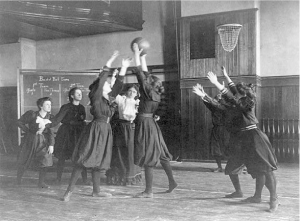The very first women’s game recorded happened only one year after the game was invented. The game spread very quickly in popularity.
Dr. James Naismith invented the game in late 1891. But, the following year in 1892 the first women’s game was organized and played. The game really did gain a very fast following on the east coast of the United States.
Senda Berenson: Pioneer
Senda Berenson organized the first game between students at all-women’s Smith College, located in Northampton, Massachusetts. Smith College is only 19 miles away from the YMCA where the game was invented in Springfield. So, proximity obviously had something to do with the fact that the women’s game started at Smith College.
Sometimes referred to as the mother of women’s basketball, Berenson was on staff at Smith College and was a huge advocate for women’s physical education.
Now this was the Victorian era and gender roles were much different back then. Now, when I say Victorian era, I am specifically speaking of when Queen Victoria sat on the throne in Britain.
Even though Queen Victoria was an ocean away many of the ideas of what women could and could not do were the same in the United States as they were in England, especially in a private university environment where the students were almost exclusively from the upper class.
There were many at the time who thought that physical exertion was a potential danger to women. They thought that getting sweaty or pushing oneself physically could lead to fainting or even what they used to call “nerves.” In other words, they thought that for women to exercise, it could cause them to have a physical or mental breakdown. Of course, we know now that none of that is true.
We see women today running triathlons, marathons, all kinds of professional sports, American Ninja Warrior, and Spartan Races where they are jumping through fire and climbing walls. In many countries, women can now occupy any position within the military. Thankfully we know more today about women’s physiology than we did back then.
But, in any case, that was the cultural context where women’s basketball started. Berenson was a huge advocate for women’s athletics. In her opinion, there was no reason that women could not participate in demanding physical activity. She was definitely way ahead of her time.
To that end, she expanded the gymnastics program at Smith College, but she wanted a team sport similar to what the men played. After looking at various options like football, soccer, baseball, and lacrosse, she decided that this new game called basketball would be just the thing to expand the women’s physical education program.
The game required running and physical exertion, but not too much.
Even though Berenson was correct in her thinking that women are just as capable of playing sports as men are, she was still a product of her time and did not want to push women too hard. At least not right away.

Different Rules for Women
So she took Naismith’s original rules and adapted them for women to play the game. Now back in the very early days of basketball, they approached the game the way you would approach soccer, or as the rest of the world calls it, football.
The very first basketball game, in 1891, featured 18 players on the court at the same time in a 9-on-9 game. There was no strategic reason for this, it was just that there were 18 players in the gym that day and nobody knew otherwise. So, because there were so many players out there they spread out like soccer players with three defenders, three midfielders, and three forwards. They would pass and move the ball similar to the way soccer players do.
So, this was the basis for Berenson’s ideas for women’s basketball. She decided that it was best if the basketball court were divided into three zones. Each team fielded nine players exactly like I just described above; three defenders, three midfielders, and three forwards. Each group of three would occupy a zone on the court. Players were forbidden from crossing into either of the other two zones.
Each player had to stay in her assigned zone. This limited how much ground each player could cover. Remember, Berenson wanted physical activities for women, but she did not want to push them too hard. So, if a defender came into possession of the ball she would have to pass it up to a midfielder on her team who would then look to pass it further up to a forward who could then take a shot, as long as you did not move out of your zone.
The uniforms, well, those were made of wool. They were long-sleeved with a sailor collar. The pants were bloomer-style trousers. The trousers cinched at the knees and they wore knee-high socks. The whole thing was very bunchy and loose. They basically looked like medieval page boys.

The Actual Game
Berenson organized a game between the freshman and the sophomores of Smith College. Men were not allowed to even watch the game out of a sense of sensitivity and modesty for the women, and Berenson was the referee for that first game.
As she went to center court to toss the ball for the opening tip-off, Berenson’s arm made contact with the arm of a sophomore and dislocated the player’s shoulder. That was not a great way to start by injuring a player on the opening tip-off. A bench player was brought in and the game re-started. After two halves of 15 minutes each, the sophomores won 5-4. Remember, back then each basket only counted for a single point.
By all accounts, the game was a success. The players had a really good time. They enjoyed physical exertion. The game was not too taxing on their endurance, especially with the rules about using 9 players across three different zones. The game proved that women could handle this level of exercise.
But Berenson’s vision for the women’s game was for physical fitness and fun, in that order. She never intended for the game to become competitive. She felt that the idea of cold-blooded competitiveness was too masculine of a trait for good, wholesome young women who came from some of the best families in the northeast. But, anytime you start a new game, competitiveness is sure to follow.
The Women’s Game Expands
The game was played with Berenson’s rules for about four years. The game spread to other colleges very quickly. But, the game was intramural at this point. By that, I mean that the games were played by teams made up of students from the same school. So, in effect, each school that played the game was its own little league.
Soon, people realized that women were not all that tired after playing a game by these rules. It was obvious that they could be pushed a bit more, physically. Some schools transitioned to a 6-on-6 game with only two zones, three on defense and three on offense. The midcourt line divided the court in half and was the boundary of each zone.
This definitely opened up the game to move a little faster since only 12 players occupied the court, not 18. This made the game more exciting. There was much more space to maneuver and that led to more creativity on the part of the players.
Some schools played 9-on-9 with three zones, while other schools went to 6-on-6 with two zones. There was no uniformity to how different schools played. There was no governing body for basketball at the time. Everybody was just doing their own thing, playing however they thought was best.
Then in 1896, the first official women’s college basketball game was played. Someone finally got the idea and said, hey, let’s take all of the best players from our school and make a team. We will then challenge another school to put together a team of their best players and we’ll have a game.

Stanford vs Berkeley
Stanford University and UC Berkeley played the first intercollegiate women’s game. The two schools are located in the San Francisco Bay area, which made it easy for scheduling and traveling.
On April 4, 1896, the two schools played each other in a 9-on-9 contest using the three zones with Stanford winning 2-1. Around this same time another leader in women’s basketball, named Clara Baer, published the first book of rules for women’s basketball. It was an attempt to make the game uniform across the country. It sort of worked.
Many schools did jump on board with Baer’s rules, but others continued to play their own version of the game. Unfortunately, Berkeley, Stanford, and a bunch of other schools banned women’s intercollegiate sports. In the end, they just did not feel it was very ladylike to have the women compete at this level.
But, that did not mean that women stopped playing basketball. As the 20th century wore on there were other ways to play because the sport was fun to play and exciting to watch. In 1924 and 1928 women’s basketball was played at the Olympics as an exhibition sport. The teams still received a medal if they placed 1st, 2nd, or 3rd, but the sport was not made permanent at the Olympics until 1976, just five years after 5-on-5, full-court basketball was approved for women at the collegiate, professional, and Olympic levels. Yes, you heard that right.
Regular 5-on-5 women’s basketball was not approved across all of the top levels until 1971. That was a decision that was way overdue. It took 80 years to go from 9-on-9 down to 5-on-5 as it became obvious that women could run full-court without having a nervous breakdown.
Women’s Basketball Around the World
Throughout the 20th century, there were a few women’s barnstorming teams. Women could play basketball through the AAU, or Amateur Athletic Union. The Pan American Games included women’s basketball starting in the 1950s. But I am not going to pretend that they had the same opportunities as the men.
They did not. There were definitely opportunities, just not anywhere near as many as for the men. It was not until Title IX legislation was passed in the 1970s that we saw a massive return to women’s collegiate athletics.
Title IX
Let me take a moment and explain what Title IX legislation is. In the United States, Title IX was a body of legislation that required equal opportunities for women. It actually covered a range of areas, but as far as sports were concerned it required any government school that offered sports to budget equal amounts of money for the men as they did for the women.
So, if your school spent $1 million on the men’s teams, it had to also spend $1 million on the women’s teams. That caused a bunch of high schools and colleges all over the country to create women’s teams in a bunch of different sports in order to keep that balance in their budgets. This was an enormous boost for women’s athletics in the United States.
Now, imagine how much further we would be in the area of women’s sports if they had been able to play for the last 130 years when the game was invented, instead of just the last 45 years since the passing of Title IX legislation. But, the funny thing about history is that we can analyze it, discuss it, debate it, but we cannot change it. What is done is done. The beauty, however, is that we can learn from it.
And there is a lot to learn from women’s athletics in general and women’s basketball in particular.
Hall of Fame
Senda Berenson was inducted into the Basketball Hall of Fame in 1985 for her efforts in organizing that first women’s game. All of the people that came after her to help promote the women’s game even further deserve a lot of credit.
Women play basketball all over the world and the popularity continues to grow. The women’s game is in good hands.
More Basketball History
Bill Walton’s Feet: A Legacy of Pain and Progress
How does a player who spent 14 seasons in the...
Read MoreHistory of NBA Team Nicknames: Atlantic Division
I love the history of sports team nicknames. Today I...
Read MoreHistory of NBA Team Nicknames: Pacific Division
I love the history of sports team nicknames. Today I...
Read MoreCheryl Miller – Greatest Women’s Basketball Player of All Time?
Imagine that you are one of the most skilled people...
Read More


